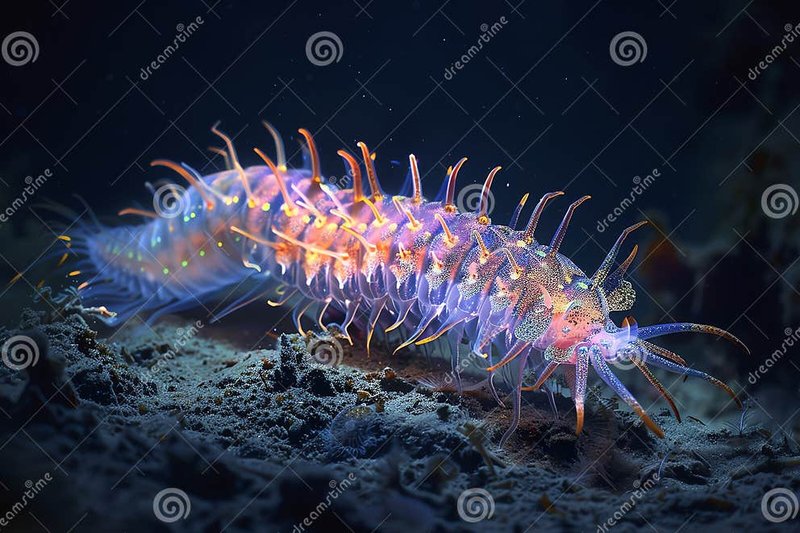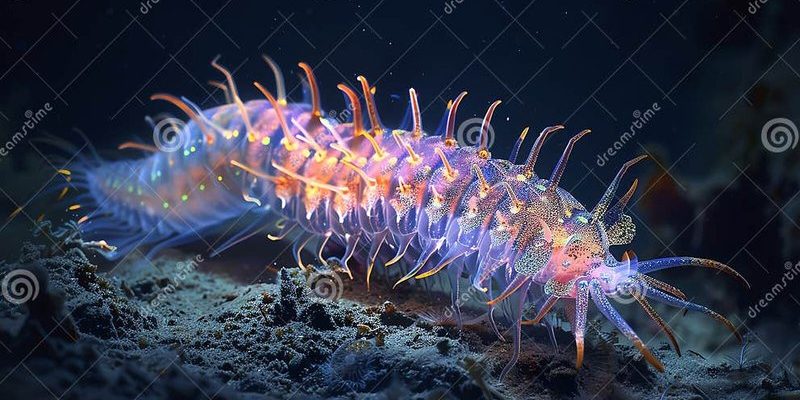
Bristle worms belong to the class Polychaeta, which includes a wide array of marine worms. While some species are pretty plain, others are sophisticated light shows in their own right. These worms use their glowing capabilities for different reasons, from attracting mates to warding off predators. With each pulse of light, they tell a story of survival and adaptation in the ocean’s depths. So, grab a drink, settle in, and let’s dive into the stunning world of bioluminescent bristle worm species together!
What Are Bioluminescent Bristle Worms?
Bioluminescent bristle worms are marine creatures that have the incredible ability to produce light through chemical reactions in their bodies. This is known as bioluminescence, a phenomenon that many organisms, from fireflies to certain fungi, exhibit. Think of it like a built-in flashlight, enabling them to shine brightly in dark oceanic environments.
These worms possess specific cells called photocytes, which contain the necessary compounds for light production. When they’re threatened or need to communicate, these cells release compounds that react and create a stunning glow. This natural glow can vary in color, often appearing in shades of blue or green, making them truly mesmerizing.
For the bristle worm, this glowing skill serves several purposes. It can be a diversion against predators, a way to attract mates, or simply an essential part of their behavior. The diversity of bioluminescent bristle worms is vast, and some species can even change color based on their surroundings, making them the chameleons of the sea!
The Role of Bioluminescence in Survival
You might be wondering why bioluminescence is so critical for these worms. Well, it’s all about survival! The ocean is a tough place, filled with predators looking for a snack, and bioluminescent bristle worms have developed this glowing ability as a smart defensive strategy.
When faced with danger, these worms can emit a bright flash of light, temporarily stunning or confusing their predators. It’s like throwing a smoke bomb in a chase—it gives them a chance to escape. Some species even release glowing mucus, which can further distract predators, allowing the worms to wriggle away into the safety of the seafloor.
Moreover, bioluminescence isn’t just about avoiding being eaten. Some bristle worms use their glow to attract mates. During mating season, both males and females might light up to signal their readiness to breed. Think of it as a romantic glow-in-the-dark party beneath the waves!
Unique Species of Bioluminescent Bristle Worms
There are several notable species of bioluminescent bristle worms, each with its unique glow and characteristics. Here’s a quick look at a few:
- Odontosyllis enopla: Known for its spectacular light shows, this species can create dazzling displays by synchronizing its bioluminescence with others of its kind. When they light up together, it looks like a mesmerizing underwater light show.
- Syllis ramosa: This worm emits a softer glow and is often found in shallow waters. Its bioluminescence helps it attract small prey and potential mates, making it a multitasker in the ocean.
- Hyalinoecia tubicola: Commonly found in marine environments, this bristle worm produces a blueish-green glow. Its light serves both defensive and mating purposes, creating a fascinating dynamic in its daily life.
Each of these species contributes to the broader narrative of life in the ocean. They showcase the diversity and creativity of nature’s adaptations, and studying them can help us understand the delicate balance of marine ecosystems.
How Do Bristle Worms Produce Bioluminescent Light?
The science behind bioluminescence is absolutely fascinating! In simple terms, when a bioluminescent bristle worm is triggered to glow, a chemical reaction occurs inside its body. This reaction involves a light-emitting molecule called luciferin and an enzyme called luciferase.
Here’s how it works: when luciferin combines with oxygen, the luciferase enzyme speeds up the reaction, resulting in light. This light can be constant or intermittent, depending on the species and the situation. Think of it as a controlled spark that these worms can turn on and off at will.
Interestingly, this bioluminescent process is energy-efficient. It’s often referred to as “cold light” because it produces little to no heat—much like LEDs compared to traditional light bulbs. This efficiency allows bristle worms to illuminate their surroundings without draining their energy reserves, which is crucial for survival in the vast ocean.
The Importance of Researching Bioluminescent Species
Studying bioluminescent bristle worms isn’t just about marveling at their beauty. It has significant implications for science and medicine too. Researchers are investigating these creatures to unlock potential benefits for humans.
For example, scientists are exploring how bioluminescent proteins can help in medical imaging and diagnostics. The unique properties of these proteins could lead to advancements in how we visualize and understand biological processes within the human body.
Additionally, understanding bioluminescent systems can contribute to environmental monitoring. Bioluminescent organisms can serve as indicators of ecosystem health. If their populations fluctuate, it might signal changes in water quality or climate conditions.
By studying these glowing creatures, we not only appreciate the wonders of nature but also pave the way for technological and environmental advancements that can benefit humanity.
Where to Observe and Learn More
If you’re eager to see bioluminescent bristle worms in action, consider planning a visit to an aquarium or marine research center. Many institutions showcase these fascinating creatures and offer educational programs that delve into their biology and the science of bioluminescence.
Additionally, you can explore tide pools or coastal areas during nighttime when bioluminescent organisms often glow. Just remember, it’s essential to respect natural habitats and observe from a distance to minimize your impact on these delicate ecosystems.
There are also plenty of documentaries and online resources to learn more. Platforms like YouTube feature captivating videos that reveal the nightlife of these underwater wonders. You might even find footage of bioluminescent bristle worms dazzling in their natural habitat.
Exploring the world of stunning bioluminescent bristle worm species is like discovering a hidden treasure beneath the waves. These glowing creatures not only inspire awe but also highlight the intricate relationships in marine ecosystems. By understanding their role and the science behind their bioluminescence, we can appreciate the delicate balance of life in our oceans.
Whether you’re enchanted by their light displays or intrigued by their ecological roles, bioluminescent bristle worms remind us of nature’s wonders and the importance of preserving them for future generations. So next time you think about the ocean, imagine the dazzling light shows just waiting to be explored!

